

Embedding Assessment Throughout the Project (Keys to PBL Series Part 5) Peggy: Different than a traditional classroom, PBL's gonna integrate assessment throughout the project.
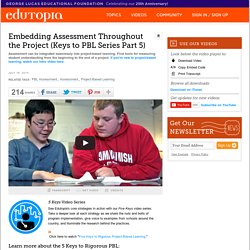
Because these projects are multi-week projects, you need to keep on top of students and build in opportunities to assess where they are and what they're learning as you go along. Sheela: From the minute a teacher introduces that learning target for the lesson, or engages in strategic observation, we feel that the assessment process is in play. Liza: It's not a test at the end of the week or the end of the unit. You're doing a lot of small check-ins with the students to see where they're at and to see that they're growing a lot. So some examples of formative assessments that I use in my classroom is fist to five. Sheela: You really have to know what kids know and don't know. Marianne: You saw another form of assessment, which we call a quick check, or checking for understanding, and that's sort of the thumbs up. Facilitating Learning in a Student-Driven Environment (Keys to PBL Series Part 4)
Liza: So when you're working on projects and you really have student-driven lessons, it can be scary because you don't feel like you're in control, but you really are.
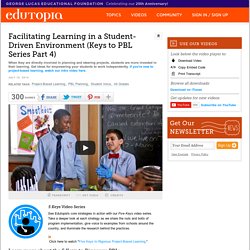
If you are planning the right way ahead of time, you are scaffolding every single aspect of that lesson and what the students are doing. You may say to yourself, it's way too much, there's too much to do. Structuring Collaboration for Student Success (Keys to PBL Series Part 3) Peggy: The teacher doesn’t just throw control to the students and say, "Let me know what you figure out.
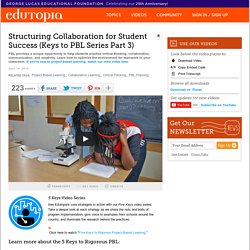
" She really has to plan ahead of time, she has to figure out how to group the students so that they're the most productive. She has to scaffold their work, so she provides hints or clues or templates, worksheets is necessary, to kinda show them what they need to do first, what they might consider doing next. She has to teach them how to work together. Teamwork is not something that comes naturally, especially for younger students. They really need to learn how to do that. Sheela: So we would have a anchor or a set of expectations about what kind of language would be used, what the roles and responsibilities are for each person in that group. Student: So you start with one trail mix and give out stickers.
Student: I do the sticker charge thing. Student: Oh, that makes sense. Building Rigorous Projects That Are Core to Learning (Keys to PBL Series Part 2) Steven: A lot of people think that Project Based Learning is fluff.
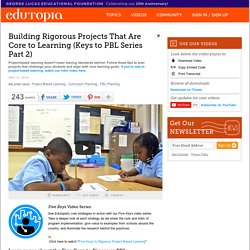
So what we did, instead of having a three-column rubric that has "Unsatisfactory, Proficient and Advanced," we added a fourth column. It is the "Standards," what has to be taught. Peggy: Students are going to address the content that they need to learn through this PBL approach. PBL provides the meat of the curriculum. It's not a side thing you do at the end of the unit for fun. Lisa: I start with the standards in mind. Steven: Our students still take assessments, district assessments, and benchmarks. Five Keys to Rigorous Project-Based Learning. Voiceover: How will today’s children function in a dangerous world?
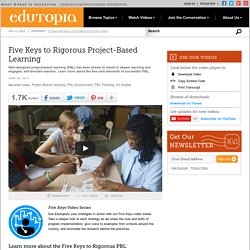
What means will they use to carve the future? Will they be equipped to find the answers to tomorrow’s problems? Teacher: When you think about traditional learning you think of a student sitting in a classroom and being talked at. Teacher: Now I imagine a lot of you are still thinking... Teacher: They are supposed to be a sponge. Peggy Ertmer: So there are a lot of different ways to approach PBL, a lot of different ways to implement it, but really it all boils down to five essential keys: real-world connection, core to learning, structured collaboration, student driven, and multifaceted assessment.
Student: One of the problems in the ocean is that with the higher amount of CO2 calcifying organisms are decreasing and we’re testing to see how well life in the ocean lives without calcifying organisms. Student: --four by eight feet. Peggy Ertmer: So the second commonality is the PBL unit provides academic rigor. Establishing Real-World Connections in Projects (Keys to PBL Series Part 1) Peggy: Usually by starting with an authentic problem in the community, or in the neighborhood, you anchor the unit with a driving question.

So students are given this question, for example, "What's in our water? And how did it get there? " And then the students choose different paths to explore that question.